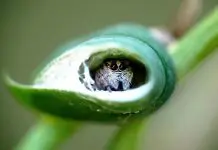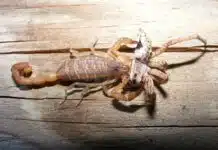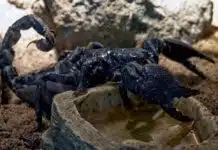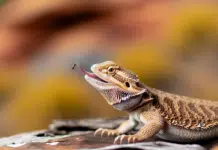Ball pythons are not the easiest pet snakes to care for owing to their high sensitivity to temperature and filth. This increases the rate of a bacterial infection, scale rot in pet snakes.
What is scale rot?
Scale rot is the term used to describe all bacterial, dermatitis or skin infections among captive reptiles. Scale rot is common among pet reptiles and it is caused by an overly damp living environment and irregular and substandard cleaning of the snake’s terrarium. It can occur on the head, the spine and more often on the belly and neck of your snake.

Originally found in West through Central Africa, these exotic pets live on the grassland and the edge of the rain forest. Their natural surrounding gives them a chance to regulate the temperature and humidity levels, a condition you must adequately replicate if you want your ball python to stay with you for more than two decades.
As the snake continues to lie in a wet and unclean substrate with fecal matter and rotting food, the skin can get infected. At first, the ball python scales will turn red and you will see clear or bloodstained fluid discharges. This may not be ball python scale rot but it is the perfect condition for it to occur. Over time, the skin turns red and gets swollen opening a gateway for harmful bacteria such as Pseudomonas spp to get under the snake’s skin. Other times the bacteria form abscesses that produce pus which leaves behind ulcers after a shed.
It can stop your pet from feeding properly and destroy the luscious skin of your snake especially if it is on the belly which is the softest part of the snake. As it progresses, the area gets swollen, forms blisters and the scales slough off. If left untreated, the bacteria eat into the snake, gets into its bloodstream and internal organs causing septicemia, which can be fatal.
In case you are wondering, what are snake scales made of that makes it vulnerable to infections, it is made from keratin, the same substance responsible for nails in humans. These scales retain liquid and moisture and help them glide over rough surfaces.
Can Scale Rot Kill a Snake?
Study shows that juveniles and snakes with a weakened immune system are more susceptible to the disease. A snake’s immune system can be weakened when it suffers from malnutrition, stress, previous illness and other diseases. They can die from the septicemia in days while it may take weeks for the disease to kill larger healthier snakes.
It is not lethal in small doses but if not properly treated it can result in death. To know if your snake has scale rot, regularly turn the snake on its back and check for any splotch in the underbelly. You don’t want to wake up and find that your pet has died over the night because you did not know what or how to check your snake for scale rot.
Note however that there is a difference between skin shedding and scale rot. While both processes turn the underbelly of the snake red, scale rot is accompanied by large blisters and scales erosion on the stomach, the neck or the full length of the underside of the snake.
When the infection is treated, the snake may shed a few times or at its pre-scale rot rate before it is healed completely. It does not leave any blemish on the snake’s skin once the infection is treated and a scale rot treatment administered.
Scale rot vs Mouth rot
Although they are both bacterial infections, mouth rot starts as an injury in the mouth caused by the loss of a tooth or scratches from prey. This goes on to be infected in a dirty environment or if the snake has a weakened immune system. As in the case of scale rot, the bacteria find its way into the snake’s bloodstream and causes sepsis which can be fatal.
To identify mouth rot, open your snake’s mouth with a tong or with your hands while wearing latex gloves. Look out for any redness, swelling or pus. If the infection progresses, you will see discharges from the mouth and nose.
Causes of scale rot
The main cause of scale rot in reptiles is unsanitary and poor management of the living environment. An extremely moist habitat and a contaminated substrate increase the risk of scale rot in reptiles.
Increase in bacteria. This is often because the enclosure is dirty due to bad husbandry, non-removal of feces and remnant food, or that the cage is not being cleaned often enough. It could also be a result of the snake lying in its filth.
Keeping your pet in a wet cage for an extended period can cause scale rot. It is not the wetness of the cage that causes scale rot, but the bacteria which grow in this condition. If your snake has blisters, it could get infected.
The inability of captive snakes to dry themselves. Being cold-blooded animals, snakes often seek out heat to dry themselves and improve their immunity to diseases. If a snake is not at the right temperature, its immune system suffers and it cannot fight off a belligerent intruder.
Ignoring damaged scales. If your snake’s scale gets damaged from climbing a rock or a log, the time you took it outside, or your friends played with it, and it was returned to its cage without the damaged scale treated, it could contact scale rot.
Extreme temperature or humidity levels in the snake’s tank. If there is an increase in temperature, it will create more heat which will, in turn, increase the humidity in your closure. Ensure the temperature in the snake’s enclosure is about 90 degrees and the snake can get its outer skin temperature to 80 – 85 degrees.
Shortage of vitamins A or C. Your snake will experience a shortage of nutrients when it is malnourished or not fed regularly.
Symptoms of scale rot
There are many ways by which scale rot presents itself. Sadly, your pet cannot tell you it is in pains or that its stomach hurts which leaves it up to you to pay attention to the appearance of your snake. Early detection of snake scale rot makes it less deadly and makes treatment more effective, simple, quick and inexpensive for you. Here is some ball python scale rot early signs to look out for.
Discoloration
A sign of the infection may manifest itself on the visceral area of the reptile. To diagnose any symptom of scale rot, turn the reptile on its back and examine its stomach. If the abdominal region has spots in the form of brown, red or blackish scales which look crusty, your snake might have scale rot. Discoloration can be found on the tail region and areas that come into constant contact with the stimuli.
Raised scales
Besides being discolored, the infectious bacterial also cause swelling and raising of scales of the affected region. Raised scales also occur where there are pools of blood under the scales.
Blisters
Blisters are diminutive cavities on the snake’s skin. They can be found on the underside of the snake which has the most contact with the contaminated substrate. Initially, the cavities are filled with bacteria-free fluid which is usually clear or creamy. The presence of blisters doesn’t always mean your pet has scale rot.
However, if left unattended, bacteria from the environment can pollute the blisters and causes the scales to rot. Also, if snake mites are present in the snake’s enclosure, it can carry bacteria to the blisters. Although uncommon, skin infection can be caused by certain fungi such as yeasts which contaminate the vesicles.
Loss of appetite
You might want to check for scale rot when your snake stops eating as much as it used to. Generally, loss of appetite in a pet should be taken seriously. You need not fret as we will discuss how to cure snakeskin when the scale rot is mild.
How to treat scale rot
There are a couple of ways to treat scale rot yourself when it is just beginning. Studies have shown that a lack of proper sanitary hygiene and malnutrition can cause scale rot.
When you notice blisters on your snake, treat it immediately. Snake blister disease is the forerunner of scale rot, the one who announces a king if you like. While you can just have blister disease, you can’t have scale rot without Blister disease in snakes.
Before handling an infected snake, you might want to sterilize your hands so you don’t increase contamination to your snake. The F10 hand gel is a great choice to sterilize your hands while you are handling your animal. Use a pet-friendly first aid spray on the area or surface you are going to put your snake on. Pay attention to how your snake reacts to the products you use. If it reacts with a lot of stress, you might want to discontinue the use of the said product.
1. Quarantine the Affected Snake and Sterilize the Terrarium
If you notice your snake has been infected, the first thing to do is to quarantine it. If you have more than one snake in the enclosure, you might want to separate it from the others as you treat it. You have to check that the other snakes are not infected. Sometimes putting an infected snake in a clean, dry and well-ventilated space is all you need to put an end to scale rot progression.
Sanitizing your snake’s enclosure is the first step to treating the disease. Change the substrate and clean the cage. Clean any hides, logs or rocks with disinfectant water. Be careful not to use a disinfectant that is toxic or will cause irritation for your snake.
2. Betadine Bath Solution

One of the ways to treat scale rot is to use a betadine solution. Betadine is a liquid antibiotic that is readily available online and in pet stores around you.
Immerse your snake in a betadine solution bath, twice a day for 20 minutes until the condition clears. Ensure that the bathwater is neither cold nor hot.
When you turn on the cold tap and directly submerge your snake into the betadine solution, it can cause severe shock in your cold-blooded snake.
To create less stress for your snake, make sure the temperature of the water is not cooler than the cool side of its habitat. Depending on the extent of the scale rot, use more or less betadine as you deem fit.
After the bath, rinse and dry the snake and use Neosporin ointment. Be careful to not get it into the eyes, mouth or vents of your snake. An antibiotic spray such as vetericyn solution spray for reptile wound and skincare plus, both safe, non-toxic and non-irritating can be used. It can even be used for a snake without scales. If the condition keeps deteriorating and doesn’t improve, do see an exotic animal vet.
After the bath and ointment application, put your snake in the driest environment you can find or create, it has to be clean of course. You don’t want any humidity around your snake at this time so you might want to take out the drinking bowl and put it in every few hours.
3. Tamodine Application Solution
Another antibiotic therapy is to apply an ointment directly to the affected area. After sterilizing your hands and work station, you will lay the snake on a flat surface. In this method, get an antibiotic cream such as tamodine and silver sulfadiazine. You can apply it topically or dilute it with water. You will be needing a water spray, a little empty dish, and some cotton buds.
Pour some of the cream into the dish and soak the cotton bud in it. With a little pressure and in a circular motion, apply the cream to all affected areas of the snake, getting it under the scale. Let it sit for about 10 to 15 minutes and wash or clean it off. If your snake is not great with baths, you might want to clean it with a sterilized wipe.
Finally, apply a germicidal barrier on the affected area to stop any reinfection. Return the snake to its already cleaned and dry enclosure. To ensure the scale rot is eliminated, it is advisable that you carry on with the treatment for a couple of weeks and not stop when you see that your snake is doing better.
4. Use Appropriate Substrate
Preventing scale rot in your snake is achievable when you maintain proper husbandry and regulate heat and humidity.
The use of appropriate bedding (substrate) will prevent scale rot and hasten the recovery process. There are a couple of factors that should influence your choice of substrate.
- It should be comfortable for your pet.
- It should be mold resistant.
- It should break down the odor.
- It should have great absorbing power.
- It should hold humidity well.
- It should keep parasites and microbes away.
Best Type of Snake Bedding (Substrate)
Let us look at some of the bedding options for your pet.
Sand
This may seem like a great choice but it isn’t. It is coarse and therefore not comfortable for your snake. Sand can get on the food and into the mouth of your snake. It is also difficult to clean.
If you prefer sand as a substrate, you might want to try out Reptile Sciences Terrarium Sand for Aquarium. It is made up of 100% Digestible Calcium Carbonate that is safe to ingest.
Astro-turf
This is a cheap novel idea snake owners are adopting. The downside to this option is that it doesn’t hide odor and soaks up feces therefore not great for your room or pet.
Check out the best prices of astroturf here.
Newspaper and paper towels
These are a great option if you are not concerned about aesthetics. They are cheap, comfortable for your pet, absorbent and easily changeable when it gets soiled.
Cypress mulch
This is a great and inexpensive substrate option. It is aesthetically pleasing, breaks down odor and holds humidity well. It is also readily available in a pet store. However, it is also a good place for mites to hide in and thrive.
If you prefer cypress mulch as substrate, be sure to check out Zoo Med’s Forest Floor Bedding that is made up of 100% natural cypress mulch.
Coconut chips
Coconut chips take the cake when it comes to snake beddings. A great example is Retichip Coconut Substrate. It is made from natural coconut chips, pet-friendly and non-toxic.
It has become one of the most sought after substrate because it holds humidity and moisture well, and is mold resistant. It is comfortable for snakes and great for them to burrow in. They are aesthetically pleasing, break down odor, great for living plants in the tank and are affordable.
They are known to expand and are long-lasting. When you are done using the chips in your snake tank, you can easily throw it in your garden as they are not acidic and break down easily.
Alternatively, you can get also try out Exo Terra Coco Husk for a similar yet affordable option.
5. Control Humidity and Moisture
Humidity and moisture in your snake’s tank are as important as getting the right substrate. Unlike substrate, getting the right humidity and moisture content is quite tedious. It is even more so for tropical snakes which your ball python falls into. They usually require a temperature that exceeds room temperature as it strengthens their immune system, improves their appearance and color vision.
The first step to regulating humidity is to understand the needs of your snake. While some snakes can withstand moist areas others come down with scale rot just after spending a few hours in a humid environment. One way to know if your cage has the right humid temperature is to pay attention to how your snake sheds. Snakes have a hard time shedding in a low humidity area, but you have to be careful so it doesn’t get too wet for your pet and increase the chances of scale rot.
Two factors necessary for humidity in your snake tanks are airflow and heat. If you can get these two under control, your snake will be more comfortable and you will be happier.
To control the humidity, do the following.
- Cover the top of your tank with a plastic wrap leaving one-third of it open.
- Do not keep your tank in places with direct sunlight or draft such as the window as this will reduce humidity.
- Use a substrate that absorbs moisture.
- Use a heat mat or a heat lamp. Heat lamps increase blood circulation in the snake thereby increasing its immunity to infections. It also burns off excess moisture in the enclosure. But this can also make the habitat dry therefore you have to control its use.
- In summer or during heat spells lower humidity by turning on the fan for a few minutes.
- Qualities you need in the right heat lamp
- It should be made from non-toxic materials.
- It should have a long life span.
- It should not emit light.
- It should have high thermal efficiency.
Heat lamps are available in pet stores and online. Some great choices are the Zilla premium reflector domes, Fluker sun dome, and Hoke flexible clamp lamp.
You are going to need a thermometer or hygrometer that can track humidity so you keep both temperature and humidity balanced for your pet at all times. You also need to create a cool area where your snake can go to when it has had enough heat.
Here are some thermometer and hygrometer options available:
- Exo Terra Digital Combination Reader is a 2 in 1 option that tracks both humidity and temperature. Hence this is definitely a cost-saving option.
- Zoo Med Repti Temp Digital Infrared Thermometer is another great option to conveniently measure temperature.
- Raytek Mini Temp IR Thermometer is a powerful infrared thermometer that can quickly and accurately get the temperature of your terrarium. However, they can be a little costly.
6. Maintain a Sanitary Habit
Living in an unsanitary condition increases the chances of your snake contacting scale rot. To keep diseases away, pick up after your snake as you would a child. Look out for food remnants and feces all the time and take them out of the enclosure whenever you find something. Similarly, do a deep cleaning of the snake’s enclosure every week. Wash the drinking bowl with warm soapy water and disinfect any rocks or hides in the snake’s enclosure. Make sure you use the best substrate you can find for your pet.
The production material of the cage is important. Usually, a snake’s pen should be either plastic or glass. Wooden cages aren’t a great choice as it is not easy to clean and can be a breeding ground for bacteria. Plastic cages are more popular among Breeders while hobbyist use glass so they can see the snake and enjoy it as it moves.
It is advisable to have a backup cage for your snake that will be kept far apart from the primary cage.
How to Properly Clean a Snake Enclosure
Items needed to clean your snake’s tank include
- Brushes for cleaning: These are an important item when cleaning a snake tank.
- Toothpick, razorblade, and knife: you will need these or kebab sticks to clean the edges and remove tough stains from the tank.
- Paper towels: these should be available at all times for spot cleaning of the cage
- Sponges: You should have a sponge to wash the cage and another to apply disinfectants
- Detergent and disinfectant: these should be mild to not cause any irritation to your snake and strong enough to kill off bacteria in the tank.
- Gloves and Googles: you will need these to protect your hands and eyes while you clean the cage.
Remove and clean any mess in the snake’s cage and on its accessories before you wash with warm soapy water
Apply a disinfectant to the tank and all its accessories and allow to sit for at least 10 minutes. If you have Rocks and hides they should be cleaned and treated. For 30 minutes boil the rock while the hide should be incinerated in an oven.
Rinse all items in warm water paying special attention to wooden or porous items which can retain disinfectant.
Lay all items out to dry completely before reintroducing the snake.
It is imperative to never wash the snake cage and items in the same sink you use for cooking or bathing. Also, keep all cleaning items separate from your household cleaning supplies so you don’t cross-contaminate as snakes are carriers of E. coli and salmonella which is disastrous for humans.
Use a sturdy water bowl that is difficult for the snake to knock over and not big enough for the snake to soak in. You would want a substrate that is comfortable for your snake, easy to clean, can absorb water, is mold resistant, breaks down odor and holds humidity well.
7. Feed Your Pet Regularly
A malnourished snake is not well-armed to fight off diseases. Ensure you study the dietary needs and feeding patterns of your snake. You also need a water bowl for small snakes that look like this or bigger bowls like this for larger snakes in your snake tank all the time. Again, study your pet to know if it requires a big bowl or a small one as some snakes drink more than others. However, do not use a bowl your snake can soak in. You should feed your adult ball python a defrosted or live mouse once or twice a week and juveniles should be fed more frequently as they are growing fast. A healthy and well-nourished snake will shed regularly, have clear and attentive eyes, have consistent behavior and regular feeding habits.
Ball pythons are one of the best snake pets as they are not venomous, do not get too big and are low in maintenance. They are the ideal choice for individuals who want unconventional pets. Learning the most appropriate ways to handle them can keep scale rot away. A clean and healthy habitat, keen observation and quick detection is the answer to all health issues your pet may have.



![Sick Axolotl, Fungus, Stress Symptoms [Axolotl Illness Guide 2025] Axolotl fungus](https://exopetguides.com/wp-content/uploads/2018/06/axolotl-218x150.jpg.webp)
















